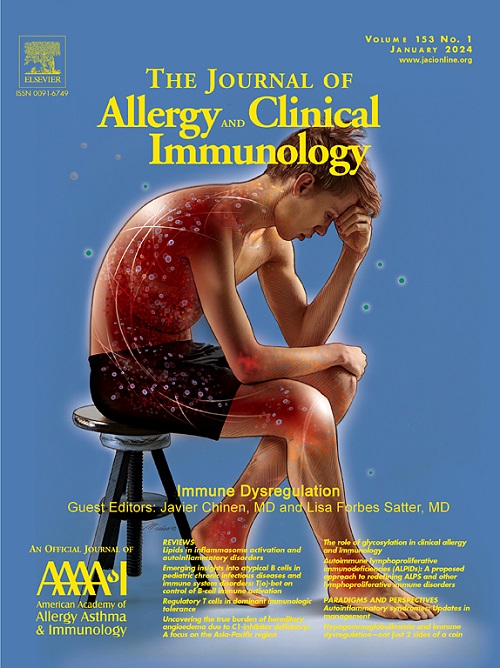美国ECHO项目中出生时儿童机会指数与哮喘复发加重的关系。
IF 11.2
1区 医学
Q1 ALLERGY
引用次数: 0
摘要
背景:环境暴露和社会决定因素可能影响特定的儿童哮喘表型。目的:我们假设出生时的儿童机会指数(COI),衡量多个邻里机会,影响哮喘复发性加重(ARE)的发病率(IRs)。方法:我们在环境对儿童健康结果的影响(ECHO)项目中测试了15877名1990-2018年出生的儿童的COI与ARE发病率的关系。父母报告的种族、民族和其他人口统计数据被评估为影响调节因素。结果:非常低COI社区出生的儿童ARE IR较高(IR=10.98;95%置信区间(CI) 9.71, 12.25)高于其他COI类别。在每个COI类别中,非西班牙裔黑人儿童(NHB)的发生率显著高于非西班牙裔白人儿童(NHW)。出生在非常低COI社区的儿童的ARE IR比非裔黑人和西班牙裔黑人(HB)儿童高几倍(IR=15.30;95% ci 13.10, 17.49;IR = 18.48;95% CI分别为8.80和28.15)。调整个体水平特征后,出生在非常低COI社区的儿童的ARE发病率比(IRR)为1.26 (95% CI 0.99,1.59), 2-4岁儿童和父母有哮喘史的儿童发病率较高。结论:在资源不足的社区出生的儿童中,ARE的发病率更高,这种关系在父母有哮喘史的年轻少数民族儿童中最为明显。即使在COI最高的类别中,NHB的较高发病率也表明,与种族相关的风险无论社会劣势如何都存在。本文章由计算机程序翻译,如有差异,请以英文原文为准。

Child Opportunity Index at birth and asthma with recurrent exacerbations in the US ECHO program
Background
Environmental exposures and social determinants likely influence specific childhood asthma phenotypes.
Objective
We hypothesized that the Child Opportunity Index (COI) at birth, measuring multiple neighborhood opportunities, influences incidence rates (IRs) for asthma with recurrent exacerbations (ARE).
Methods
We tested for COI associations with ARE IRs in 15,877 children born between 1990 and 2018 in the ECHO (Environmental Influences on Child Health Outcomes) program. Parent-reported race and ethnicity and other demographics were assessed as effect modifiers.
Results
The IRs of ARE for children born in very low COI neighborhoods was higher (IR = 10.98; 95% CI: 9.71, 12.25) than for other COI categories. Rates for non-Hispanic Black (NHB) children were significantly higher than non-Hispanic White children in every COI category. The ARE IRs for children born in very low COI neighborhoods were several-fold higher for NHB and Hispanic Black children (IR = 15.30; 95% CI: 13.10, 17.49; and IR = 18.48; 95% CI: 8.80, 28.15, respectively) when compared to White children. Adjusting for individual-level characteristics, children born in very low COI neighborhoods demonstrated an ARE IR ratio of 1.26 (95% CI: 0.99, 1.59) with a higher incidence of cases among children ages 2 to 4 years and with a parental history of asthma.
Conclusions
Rates of ARE were higher among children born in under-resourced communities, and this relationship is strongest for young minoritized children with a parental history of asthma. Higher rates for NHB even in the highest COI categories suggest that risk associated with race persists regardless of social disadvantage.
求助全文
通过发布文献求助,成功后即可免费获取论文全文。
去求助
来源期刊
CiteScore
25.90
自引率
7.70%
发文量
1302
审稿时长
38 days
期刊介绍:
The Journal of Allergy and Clinical Immunology is a prestigious publication that features groundbreaking research in the fields of Allergy, Asthma, and Immunology. This influential journal publishes high-impact research papers that explore various topics, including asthma, food allergy, allergic rhinitis, atopic dermatitis, primary immune deficiencies, occupational and environmental allergy, and other allergic and immunologic diseases. The articles not only report on clinical trials and mechanistic studies but also provide insights into novel therapies, underlying mechanisms, and important discoveries that contribute to our understanding of these diseases. By sharing this valuable information, the journal aims to enhance the diagnosis and management of patients in the future.

 求助内容:
求助内容: 应助结果提醒方式:
应助结果提醒方式:


